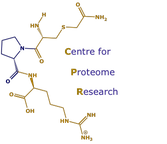BSPR, Hinxton, Cambridge
Filed in: 2010
As proteomics moves from a descriptive, discovery phase to a quantitative phase, there is increasing pressure to provide reliable quantitative data on the quantification of proteins within a cell. Most mass spectrometry-based methodologies are based on the principle of surrogacy, in which a peptide, usually tryptic, is used as a measure of protein abundance. The gold standard for such approaches, and the maximal sensitivity, is derived from isotope dilution approaches, based on stable isotope labelled peptides as chemically identical, mass resolved standards.Whilsy simple to state, delivery of robust workflows that achieve the extreme sensitivity needed for deep quantitative proteomics is challenging, and the pitfalls encountered en route are manyfold and substantive. In this presentation, I will take an overview of the construction of absolute quantification workflows, emphasizing challenges in sample preparation, standard generation and MS based analyses. I will show how these workflows can be applied to absolute quantification of an entire proteome (using QconCATs for standard generation) and the measurement of proteome dynamis by time resolved metabolic labelling with stable isotopes: 'dynamic SILAC'.
